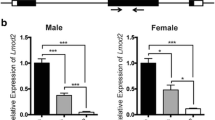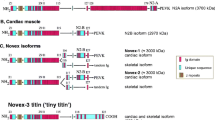Abstract
Although the role of tropomyosin is well-defined in striated muscle, the precise mechanism of how tropomyosin functions is still unclear. It has been shown that extension of either N- or C-terminal ends of sarcomeric tropomyosin do not affect cardiac myofibrillogenesis, but it is not known whether simultaneous extension of both ends affects the process. For studying structural/functional relationships of sarcomeric tropomyosin, we have chosen the Ambystoma mexicanum because cardiac mutant hearts are deficient in sarcomeric tropomyosin. In this study, we have made an expression construct, pEGFP. TPM4α.E-L-FLAG, that, on transfection into normal and mutant axolotl hearts in organ culture, expresses GFP. TPM4α.E-L-FLAG fusion protein in which both the N- and C-termini of TPM4α are being extended. TPM4α is one of the three tropomyosins expressed in normal axolotl hearts. Both confocal and electron microscopic analyses show that this modified sarcomeric tropomyosin can form organized myofibrils in axolotl hearts.
Similar content being viewed by others
References
Lees-Miller, J.P. and Helfman, D.M. (1991). The molecular basis of tropomyosin diversity. Bioessays 13:429–437.
Perry, S.V. (2001). Vertebrate tropomyosin: distribution, properties and function. J. Muscle Res. Cell Motil. 22:5–49.
Lemanski, L.F. (1973). Morphology of developing heart in cardiac lethal mutant Mexican axolotls. Ambystoma mexicanum. Dev. Biol. 33:312–333.
Lemanski, L.F. (1979). Role of tropomyosin in actin filament formation in embryonic salamander heart cells. J. Cell Biol. 82:227–238.
Zhang, C., Meng, F., Huang, X.P., Zajdel, R., Lemanski, S.L., Foster, D., et al. (2004). Downregulation of N1 gene expression inhibits the initial heart beating and heart development in axolotls. Tissue Cell 36:71–81.
Zajdel, R.W., McLean M.D., Lemanski, S.L., Muthuchamy, M., Wieczorek, D.F., Lemanski, L.F., et al. (1998). Ectopic expression of tropomyosin promotes myofibrill-zogenesis in mutant axolotl hearts. Dev. Dyn. 213:412–420.
Zajdel, R.W., Sanger, J.M., Denz, C.R., Lee, S., Dube, S., Poiesz, B.J., et al. (2002). A novel striated muscle tropomyosin incorporated into organized myofibrils of cardiomyocytes in cell and organ culture. FEBS Lett. 520:35–39.
Zadjel, R.W., Choudhury, A., Dube, S., Mehta, S., and Dube, D.K. (2000). Transfection of anti-sense oligonucleotide into whole hearts using cationic liposomes. Focus (Gibco BRL). 22:28–30.
Lemanski, L.F., Nakatsugawa, M., Bhatia, R., Erginel-Unaltuna, N., Spinner, B., and Dube, D.K. (1996). Characterization of an RNA which promotes myofibrillogenesis in embryonic cardiac mutant axolotl hearts. Biochem. Biophys. Res. Commun. 229:974–981.
Zhang, C., Dube, D.K., Huang, X., Zajdel, R.W., Bhatia, R., Foster, D., et al. (2003). A point mutation in bioactive RNA results in the failure of mutant heart correction in Mexican axolotls. Anat. Embryol. (Berl.) 206:495–506.
Luque, E.A., Spinner, B.J., Dube, S., Dube, D.K., and Lemanski, L.F. (1997). Differential expression of a novel isoform of alpha-tropomyosin in cardiac and skeletal muscle of the Mexican axolotl. Gene 185:175–185.
Spinner, B.J., Zajdel, R.W., McLean, M.D., Denz, C.R., Dube, S., Mehta, S., et al. (2002). Characterization of a TM4 type tropomyosin that is essential for myofibrillogenesis and contractile activity in embryonic heart of the Mexican axolotl. J. Cell. Biochem. 85:747–761.
Zot, H.G., Guth, K., and Potter, J.D. (1986). Fast skeletal muscle skinned fibers and myofibrils reconstituted with N-terminal fluorescent analogues of troponin C. J. Biol. Chem. 261:15883–15890.
Palm, T., Greenfield, N.J., and Hitchock-DeGregori, S.E. (2003). Tropomyosin ends determine the stability and functionality of overlap and troponin T complex. Biophys. J. 84:3181–3189.
Metzger, J.M., Michele, D.E., Rust, E.M., Borton, A.R., and Westfall, M.V. (2003). Sarcomeric thin filament regulatory isoforms. J. Biol. Chem. 278:13118–13123.
Bordzilovskaya, N.P., Detlaff, T.A., Duhon, S.T., and Malacinski, G.M. (1989). Developmental stage series of axolotl embryos, in Developmental Biology of the Axolotl (Armstrong, J.B. and Malacinski, G.M., eds.), Oxford University Press, Oxford, pp. 201–219.
Lin, J.J.-C., Helfman, D.M., Hughes, S.H., and Chou, C-S. (1985). Tropomyosin isoforms in chicken embryo fibroblasts. Purification, characterization, and changes in Rous sarcoma virus-transformed cells. J. Cell Biol. 100:692–703.
Gimona, M., Watakabe, A., and Helfman, D.M. (1995). Specificity of dimer formation in tropomyosins: influence of alternatively splied exons on homodimer and heterodimer assembly. Proc. Natl. Sci. Acad. USA 92:9776–9780.
Muthuchamy, M., Pieples, K., Rethinasamy, P., Hoit, B., Grupp, I.L., Boivin, G.P., et al. (1999). Mouse model of a familial hypertrophic cardiomyopathy mutation in α-tropomyosin manifests cardiac dysfunction. Circ. Res. 85: 47–56.
Bottinelli, R., Coviello, D.A., Redwood, C.S., Pellegrino, M.A., Maron, B.J., Spirito, P., et al. (1997). A mutant tropomyosin that causes hypertrophic cardiomyopathy is expressed in vivo and associated with an increased calcium sensitivity. Circ. Res. 82:106–115.
Martson, S.B. and Redwood, C.S. (2003). Modulation of thin filament activation by breakdown or isoform switiching of thin filament proteins physiological and pathological implications. Circ. Res. 93:1170–1178.
Maron, B.J., Shirani, J., Poliac, L.C., Mathenge, R., Roberts, W.C., and Mueller, F.O. (1996). Sudden death in young competitive athletes. Clinical, demographic, and pathological profiles. JAMA 276:199–204.
McLachlan, A.D. and Stewart, M. (1975). Tropomyosin coiled-coil interactions: evidence for an unstaggered structure. J. Mol. Biol. 98:293–304.
Author information
Authors and Affiliations
Corresponding author
Rights and permissions
About this article
Cite this article
Narshi, A., Denz, C.R., Nakatsugawa, M. et al. Cardiac myofibril formation is not affected by modification of both N- and C-termini of sarcomeric tropomyosin. Cardiovasc Toxicol 5, 1–8 (2005). https://doi.org/10.1385/CT:5:1:001
Received:
Revised:
Accepted:
Issue Date:
DOI: https://doi.org/10.1385/CT:5:1:001




